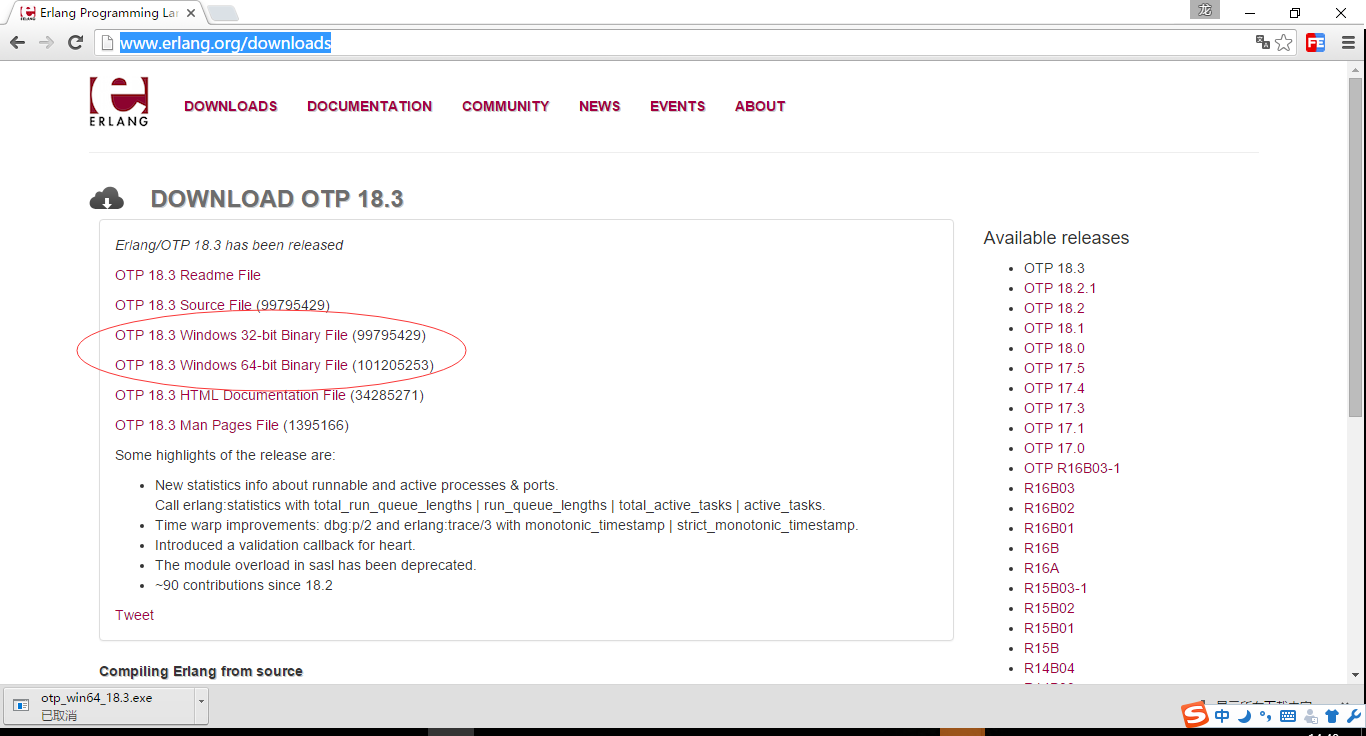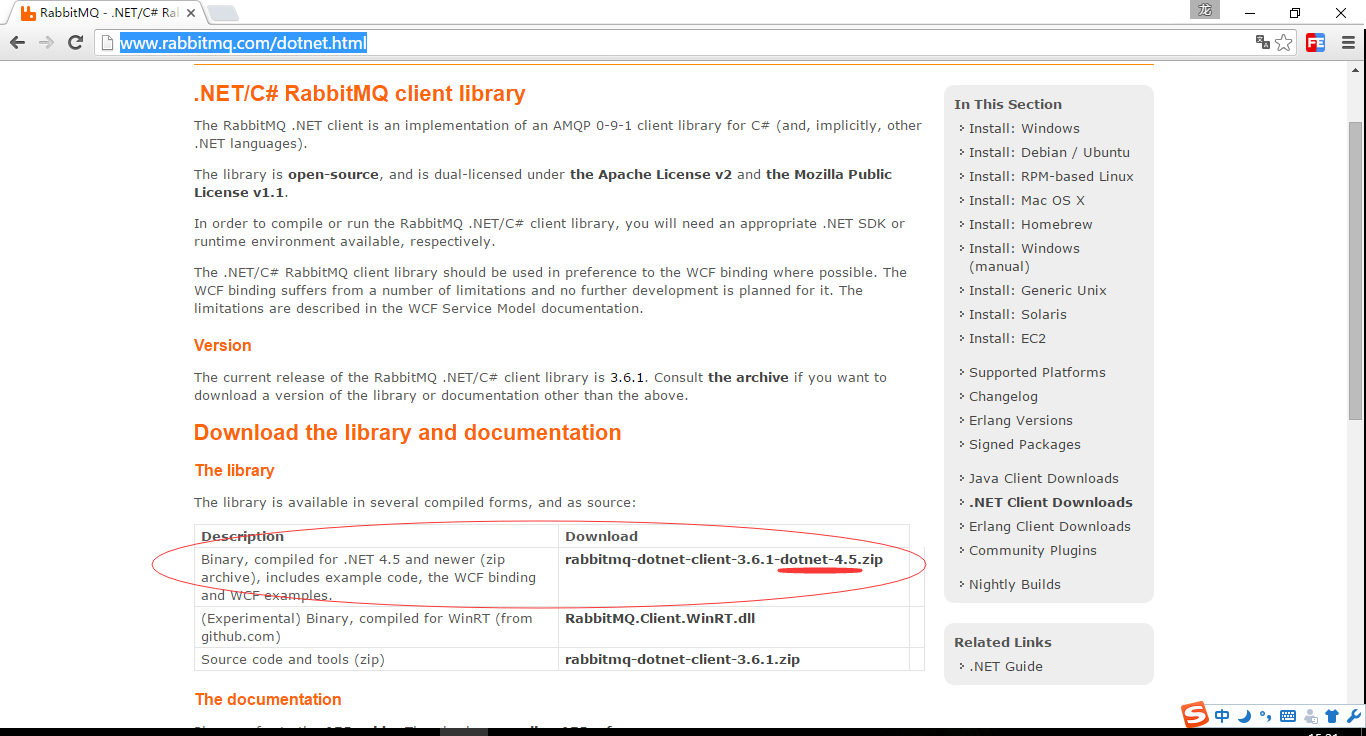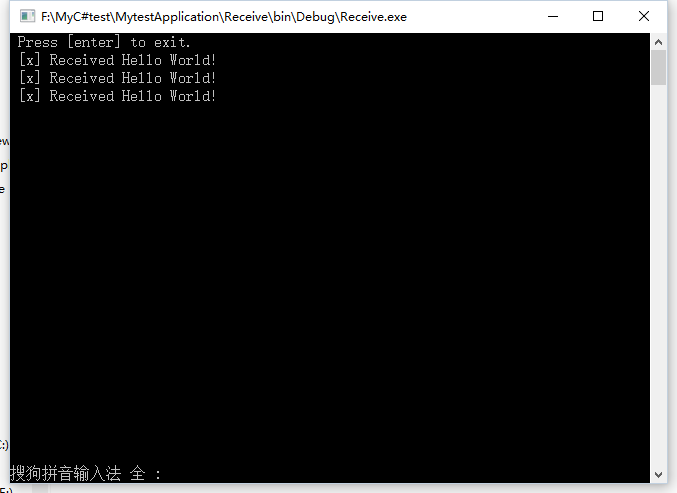C#之RabbitMQ
本文内容整理自https://blog.csdn.net/by_ron/category_6167618.html
能点进来相信你明白RabbitMQ是干什么的了,这个系列主要是本人根据
-
安装Erlang
-
安装RabbitMQ Server
-
下载客户端dll(亦称驱动)
一、Erlang安装
RabbitMQ是用Erlang实现的一个高并发高可靠AMQP消息队列服务器,分布式处理能力出众,对程序完全透明。在安装RabbitMQ服务之前必须先安装erlang,否则会发生什么呢?嘿嘿,你安装服务时会遭到提示啦。点击
二、安装RabbitMQ Server
三、下载驱动dll
点击
第一篇博文,比较简洁,着急写完,有点像完任务似的。但无论如何,我都相信,事情会越来越好的。 什么?违反墨菲定律,没错,就是这么自信!
生产者–消费者模式
上一篇讨论了如何搭建我们的开发环境,无论使用哪种语言,服务的部署肯定都是相同的。
既然是生产者-消费者模式,那么显然意味着我们会有生产者和消费者两套程序。生产者负责生产message并推送给queue,而消费者从queue中拉取消息进行处理。
生产者
首先我们需要创建一个控制台应用程序,生产者,即消息发送方,我们创建一个类Send.cs,当然,如果你愿意,也可以叫Producer.cs或者F**k.cs等等。 还记否,上一篇我们已经下载好了驱动,即RabbitMQ.Client.dll,现在只要在此项目中引用即可。
代码中这样引用即可(哎,官网就是这么详细,稍有常识的猿直接跳过)
using System;
using System.Text;
using RabbitMQ.Client;123
接下来就可以和RabbitMQ Server创建连接了:
class Send { public static void Main() { var factory = new ConnectionFactory() { HostName = "localhost" };//创建代理服务器实例。注意:HostName为Rabbit Server所在服务器的ip或域名,如果服务装在本机,则为localhost,默认端口5672 using (var connection = factory.CreateConnection())//创建socket连接 { using (var channel = connection.CreateModel())//channel中包含几乎所有的api来供我们操作queue { ... } } } }
很简单的对不对,接下来给出Send.cs的完整代码,为了方便理解,注释我会写在代码中:
using System; using RabbitMQ.Client; using System.Text; class Send { public static void Main() { var factory = new ConnectionFactory() { HostName = "localhost" }; using(var connection = factory.CreateConnection()) using(var channel = connection.CreateModel()) { //声明queue channel.QueueDeclare(queue: "hello",//队列名 durable: false,//是否持久化 exclusive: false,//true:排他性,该队列仅对首次申明它的连接可见,并在连接断开时自动删除 autoDelete: false,//true:如果该队列没有任何订阅的消费者的话,该队列会被自动删除 arguments: null);//如果安装了队列优先级插件则可以设置优先级 string message = "Hello World!";//待发送的消息 var body = Encoding.UTF8.GetBytes(message); channel.BasicPublish(exchange: "",//exchange名称 routingKey: "hello",//如果存在exchange,则消息被发送到名称为hello的queue的客户端 basicProperties: null, body: body);//消息体 Console.WriteLine(" [x] Sent {0}", message); } Console.WriteLine(" Press [enter] to exit."); Console.ReadLine(); } }
好的,接下来启动程序,我们的消息就被推送到了Rabbit Server上的queue中,等待客户端的连接,也就是等待消费者拉取。如下图:

消费者
这次重新创建控制台应用程序,类名为Receive.cs,同理,你可以用自己舒服的单词去命名。
using RabbitMQ.Client; using RabbitMQ.Client.Events; using System; using System.Text; class Receive { public static void Main() { var factory = new ConnectionFactory() { HostName = "localhost" }; using(var connection = factory.CreateConnection()) using(var channel = connection.CreateModel()) { channel.QueueDeclare(queue: "hello",//指定发送消息的queue,和生产者的queue匹配 durable: false, exclusive: false, autoDelete: false, arguments: null); var consumer = new EventingBasicConsumer(channel); //注册接收事件,一旦创建连接就去拉取消息 consumer.Received += (model, ea) => { var body = ea.Body; var message = Encoding.UTF8.GetString(body); Console.WriteLine(" [x] Received {0}", message); }; channel.BasicConsume(queue: "hello", noAck: true,//和tcp协议的ack一样,为false则服务端必须在收到客户端的回执(ack)后才能删除本条消息 consumer: consumer); Console.WriteLine(" Press [enter] to exit."); Console.ReadLine(); } } }
这段代码是不是和Send很相似呢,没错,在创建连接和声明queue上没有区别! 运行程序,效果如下:
哪怕你的Send程序已关闭,但只要运行过且成功发送了,queue就会一直保存消息,直到客户端连接,这些消息才会一股脑儿发送给消费者。 你可以这样实验,在bin中debug目录下启动Send.exe,连续3次,然后再运行客户端,就会收到3条消息,如下图:
至此,我们的Hello World已经成功跑起。这个小demo当然不是仅仅用来say hello的,更多的用意是帮助我理解兔子的基本原理,提供一种高并发情形下的解决方案。相信以后公司商城发展壮大时能够用到!!!

工作队列
使用场景:Work Queue被用以处理大量耗时任务,与其等待任务处理完毕耗费大量cpu资源,还不如立即返回并交由代理worker随后处理message。
消息持久化
生产者和消费者的代码和
using System; using System.Collections.Generic; using System.Text; using RabbitMQ.Client; namespace NewTask { class NewTask { public static void Main(string[] args) { var factory = new ConnectionFactory() { HostName = "localhost" }; using (var connection = factory.CreateConnection()) using (var channel = connection.CreateModel()) { channel.QueueDeclare(queue: "task_queue", durable: true, exclusive: false, autoDelete: false, arguments: null); //At this point we're sure that the task_queue queue won't be lost even if RabbitMQ restarts. Now we need to mark our messages as persistent - by setting IBasicProperties.SetPersistent to true. var properties = channel.CreateBasicProperties(); //properties.SetPersistent(true);//此方法已经过时:“这种设置方法已经被摒弃,现在使用持久化属性取代它” properties.Persistent = true;//取代上面的写法 ... } } }
队列持久化通过durable: true声明,服务重启后队列依然存在,但如果声明为排他队列exclusive: true,则不受持久化影响,连接断开即移除。 消息持久化通过properties.Persistent = true来设置,前提是队列持久化,否则服务宕掉后消息肯定丢失,因为消息的载体队列都没了。
消息回执
在一些对准确度要求比较高的场景下时,我们可能需要收到从消费者传回的ack后才从队列删除。
收不到ack,消息会一直驻留在队列中直到连接断开,此时会发送到集群中下一个消费者去处理;
队列永远不断开呢?那么消息当然永驻队列中直到内存吃尽,这可不是好事情,所以消费端切记做好异常处理并且finally发送回执;
没有集群则连接重新打开就会再次发送给原来的消费者;
谈回worker
在我看来,worker只是消费者的另外一种叫法,只是它的功能更加特殊,本文开头也说了,消费端基本上声明队列,注册接受事件这些步骤都一样,只是配置项的不同罢了,看下worker的配置:
using System; using System.Text; using System.Threading; using RabbitMQ.Client; using RabbitMQ.Client.Events; namespace Worker { class Worker { public static void Main() { var factory = new ConnectionFactory() { HostName = "localhost" }; using (var connection = factory.CreateConnection()) using (var channel = connection.CreateModel()) { channel.QueueDeclare(queue: "task_queue", durable: true, exclusive: false, autoDelete: false, arguments: null); channel.BasicQos(prefetchSize: 0, prefetchCount: 1, global: false);//prefetchCount:This tells RabbitMQ not to give more than one message to a worker at a time. Or, in other words, don't dispatch a new message to a worker until it has processed and acknowledged the previous one. Instead, it will dispatch it to the next worker that is not still busy(Fair dispatch(公平分发):它会选择空闲的worker去处理消息,适用于对性能敏感的场景;Round-robin dispatching(轮循分发):不解释) Console.WriteLine(" [*] Waiting for messages."); var consumer = new EventingBasicConsumer(channel); channel.BasicConsume(queue: "task_queue", noAck: false, consumer: consumer); consumer.Received += (model, ea) => { var body = ea.Body; var message = Encoding.UTF8.GetString(body); Console.WriteLine(" [x] Received {0}", message); int dots = message.Split('.').Length - 1; Thread.Sleep(dots * 1000); Console.WriteLine(" [x] Done"); channel.BasicAck(deliveryTag: ea.DeliveryTag, multiple: false);//用以处理完毕后发送ack通知服务端 }; Console.WriteLine(" Press [enter] to exit."); Console.ReadLine(); } } } }
注意这句代码以及注释:channel.BasicQos(prefetchSize: 0, prefetchCount: 1, global: false) 下面是BasicQops方法的说明:
BasicQops用于设置任务分发,只有收到前一条消息的回执才会发给当前worker,否则轮循下一个worker。如果所有worker都是忙碌,那么建议添加worker设备。
说明worker的特点就是单线程处理消息,如果处于忙碌状态(未发送回执),则不会收到队列推送的消息。

小结

付费内容,请联系本人QQ:1002453261
本文来自博客园,作者:明志德道,转载请注明原文链接:https://www.cnblogs.com/for-easy-fast/p/13491961.html











【推荐】编程新体验,更懂你的AI,立即体验豆包MarsCode编程助手
【推荐】凌霞软件回馈社区,博客园 & 1Panel & Halo 联合会员上线
【推荐】抖音旗下AI助手豆包,你的智能百科全书,全免费不限次数
【推荐】博客园社区专享云产品让利特惠,阿里云新客6.5折上折
【推荐】轻量又高性能的 SSH 工具 IShell:AI 加持,快人一步
· 浏览器原生「磁吸」效果!Anchor Positioning 锚点定位神器解析
· 没有源码,如何修改代码逻辑?
· 一个奇形怪状的面试题:Bean中的CHM要不要加volatile?
· [.NET]调用本地 Deepseek 模型
· 一个费力不讨好的项目,让我损失了近一半的绩效!
· 在鹅厂做java开发是什么体验
· 百万级群聊的设计实践
· WPF到Web的无缝过渡:英雄联盟客户端的OpenSilver迁移实战
· 永远不要相信用户的输入:从 SQL 注入攻防看输入验证的重要性
· 浏览器原生「磁吸」效果!Anchor Positioning 锚点定位神器解析